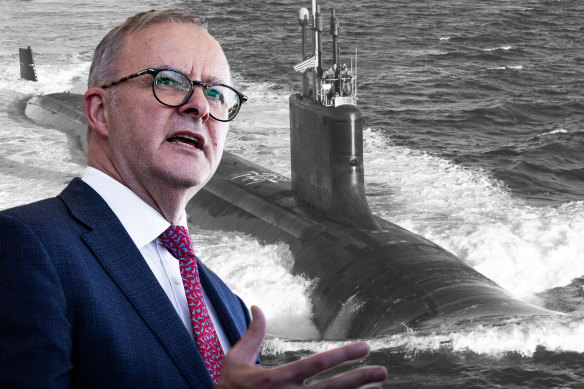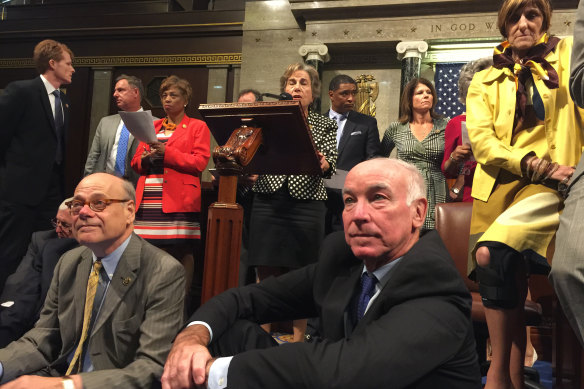This was published 2 years ago
AUKUS meeting to put Australia on track for a ’21st-century submarine fleet’
One of America’s biggest proponents of the AUKUS deal with Australia and the United Kingdom has vowed Australia will not be getting substandard submarines despite suggestions that the vessels purchased will be rebadged Virginia-class models instead of newly built boats.
Democrat Congressman Joe Courtney also told The Age and The Sydney Morning Herald that much-needed progress was being made to get through a maze of US regulations and export control laws that stand between Australia and the multibillion-dollar pact, which will be unveiled in San Diego on Tuesday morning.

Prime Minister Anthony Albanese, US President Joe Biden and British Prime Minister Rishi Sunak will meet in San Diego to announce the terms of the deal.Credit: Getty Images
Under the agreement, Australia is expected to buy up to five Virginia-class subs from the US to help safeguard the Indo-Pacific against the rising threat of China. After that, Australia will acquire a second AUKUS-class submarine, based on UK designs and US technology, from the mid to late 2030s.
After briefings from the White House and the National Security Council this week, Courtney gave the strongest signal yet that the Virginia-class submarines the US plans to sell will not be newly built, but high-quality rebadged models.
“They definitely won’t be clunkers,” said Courtney, who co-chairs the bipartisan “AUKUS caucus” and is regarded as one of Congress’ top navy experts. “I can assure you they’ll be very modern and very, very capable.
“The people that have been working at this understand the complexity of construction and acquisition, and they understand things like timing and chronology. The bottom line is I think what we’re going to see emerge is the mixture of all three countries [Australia, the US and Britain] participating in this enterprise to get Australia a 21st-century submarine fleet.”

US congressman Joe Courtney (bottom right) is the co-chair of the Friends of Australia Caucus in Washington.Credit: AP
Courtney’s comments came as Australian Prime Minister Anthony Albanese landed in San Diego late on Saturday afternoon, where he was greeted on arrival by Australia’s ambassador to the US, Arthur Sinodinos, and later at his downtown hotel by the US ambassador to Australia, Caroline Kennedy.
On Monday (US time), Albanese will meet US President Joe Biden and UK Prime Minister Rishi Sunak to unveil the long-awaited details of the AUKUS pact, including the real cost, timing and procurement.
But while Albanese has described the deal as the “single biggest leap” in Australia’s defence capabilities, many challenges remain, including securing the workforce needed to bring the submarines to service, and whether the acquisition will make Australia too reliant on the US.
While Biden supports AUKUS, he also needs the backing of a divided Congress to make good on his promise to share American submarine secrets with Australia.
This would require overhauling a litany of export control laws such as the International Traffic in Arms Regulations (ITAR), which could delay for years the transfer of crucial technologies at a time when Australia is racing to bolster its submarine capacity before the retirement of its Collins-class fleet.
“Everybody agrees it’s a huge mess,” Emily Harding, a deputy director at the Centre for Strategic and International Studies, said of America’s ITAR regulations. “But all of the different pieces to it need to be untangled in a set of difficult steps.”
Courtney and Republican AUKUS caucus co-chair Mike Gallagher have both committed to reforming the ITAR system and have even suggested giving Australia a special exemption to accelerate the delivery of its nuclear-powered fleet.
In a fresh development ahead of Tuesday’s announcement, Congress’ foreign affairs committee also put forward a bill requesting that the State Department provide an inventory of export control issues that need to be addressed in order to expedite the transfer of technology and information under AUKUS.

Prime Minister Anthony Albanese and United States ambassador to Australia Caroline Kennedy have met in San Diego ahead of the AUKUS reveal.Credit: Eddie Jim
As for the White House, Courtney said: “We’re still talking to them about what needs to be done, but there’s no question there’s some discretion they can use.
“I want to ensure that we’re all marching together in the same direction. The goal is to create a carve-out for AUKUS which avoids these [export controls] becoming barriers in terms of really getting the technology transfer that is required.”
Get a note directly from our foreign correspondents on what’s making headlines around the world. Sign up for the weekly What in the World newsletter here.